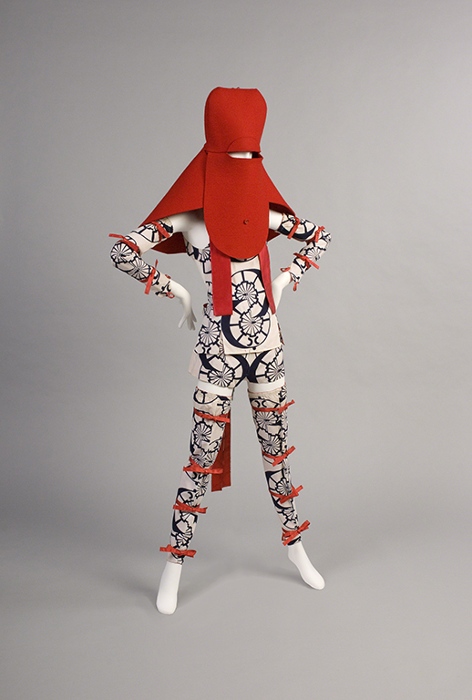Japanese Fashion: Yamamoto Kansai
Having studied fashion history in college, I’m always keen on researching unconventional designers. Kansai Yamamoto certainly fills that bill. His outstandingly avant-garde designs helped advance the contemporary Japanese fashion industry onto the world stage. He accomplished that by combining contemporary popular culture with traditional Japanese patterns and clothing types, as well as influences from traditional Japanese art. Rather than embracing the established Japanese aesthetic of transience and imperfection of beauty, called wabi-sabi (“flawed beauty”), Yamamoto designed with the intention that everyone could look fabulous in his far-out designs.
 |
| Yamamoto Kansai (1944–2020, Japan), Woman’s Playsuit: Halter Top, Shorts, Arm Guards, Leg Guards, and Hood, 1971. Printed cotton plain weave and felted wool. Courtesy of the Philadelphia Museum of Art. © 2023 Artist or Estate of Artist. (PMA-9489) |
Yamamoto's designs pushed boundaries through exaggerated proportions, often incorporating quilting for sculptural dimension. He described his fashions as being aligned with the Japanese concept of basara, meaning to dress in eccentric, over-the-top styles. It was an intentional opposition to the understated and reserved wabi-sabi aesthetic. Yamamoto once said his use of brilliant color—as seen in the hood of Women’s Playsuit—was "like oxygen."
Some of Yamamoto’s strongest looks have a Pop Art or glam rock look. David Bowie (1947–2016)—who frequently collaborated with Yamamoto in the 1970s—wore an outfit similar to the playsuit for a magazine shoot in 1971, the same year Yamamoto first brought his designs to London. Yamamoto liked to apply populist touches to his designs using imagery from traditional Japanese art, particularly Kabuki theater as seen through ukiyo-e prints.
The red felted hood of this playsuit was inspired by those traditionally worn by Japanese firefighters. The halter top, shorts, arm guards, and leg guards are made from an indigo-printed cotton usually used for yukata, unlined summer kimonos. The pattern on the suit is a conflation of two ages-old Japanese designs: the symbol for the chrysanthemum—the national flower of Japan—with a paper parasol.
Western fashion styles, called yōfuku, started creeping into Japanese fashion after the country was opened to Western trade by the U.S. and Britain in 1853. Initially, only men wore Western clothing for business. It became more commonplace after World War I (1914–1918), when Japan was rapidly building a military industrial complex in the attempt to become a world power. Japanese styles, called wafuku, have survived primarily for special occasions such as weddings or funerals.
After World War II (1939–1945), Western styles spread as the primary attire in Japan. The post-War pacifist constitution allowed younger generations to embrace popular culture and entertainment along with fashion fads—most of it influenced by the U.S. The speed of Westernization of Japanese fashion increased markedly starting in the 1960s, influenced by the hippie movement, the U.S. space program, and the overwhelming nature of U.S. commercial culture.
Born in Yokohama, Yamamoto initially studied civil engineering in high school. He majored in English at Nippon University before dropping out in 1965 to pursue a career in fashion. He served as an apprentice to designers Junko Koshino (born 1939) and Hosono Hisashi in 1968 before opening his own company, Yamamoto Kansai Company, Ltd., in Tokyo in 1971. His first collection debuted in May of 1971 at Great Gear Trading Company in London to spectacular acclaim. He was the first Japanese designer to show in London. That same year, he had his United States debut at Hess’s, a department store in Allentown, Pennsylvania, known for showing cutting-edge fashion designs.
Yamamoto considered design a form of self-realization. His name became identified with avant-garde designs, sculptural tailoring, and a layered approach to dressing with the use of bright color and patterns. He was known for his "super shows" that combined runway models, music, dancing, and entertainment for thousands of attendees.
Self-expression was the mantra of Yamamoto's clothing designs, reflected in clothing that showcased gender fluidity, rejecting the rigid societal norms that usually governed fashion designers at the time. Yamamoto's fashions encouraged positive cultural exchange between East and West. Although his work was often inappropriately appropriative, gimmicky, or self-consciously pushing “otherness,” his work paved the way for other Japanese designers in the international fashion scene in the 1970s, including fashion giant Issey Miyake (1938–2022).
Correlations to Davis Programs: Explorations in Art Grade 1: 5.8; Experience Art: p.66; A Personal Journey 2E: 3.3; Fashion Fundamentals: Chapter 6; Experience Painting: p. 108


Comments